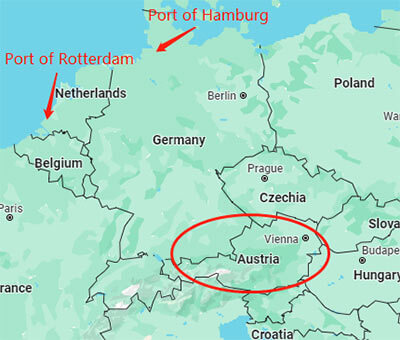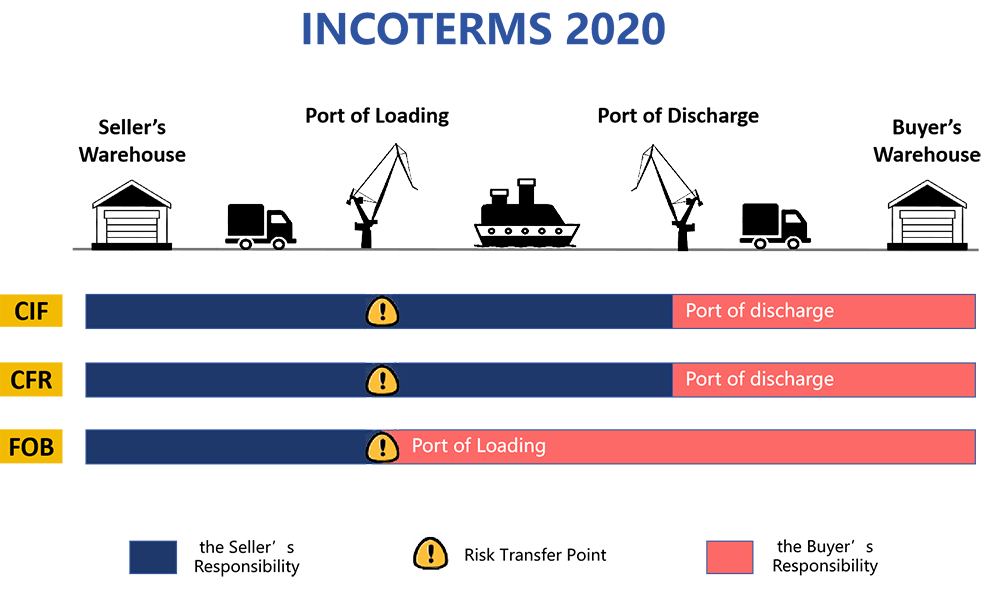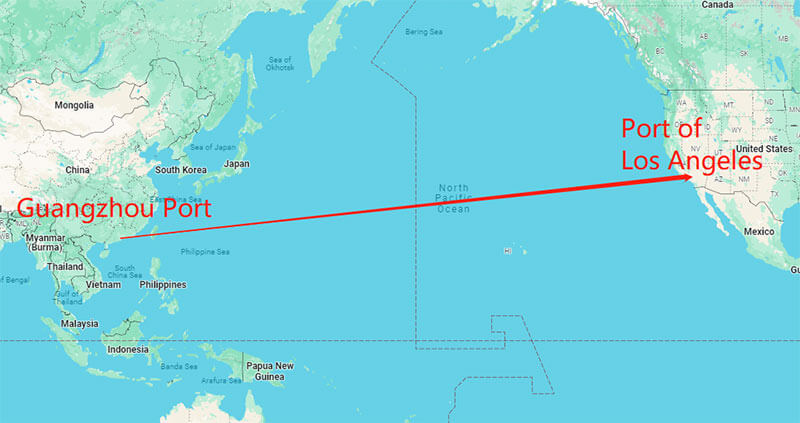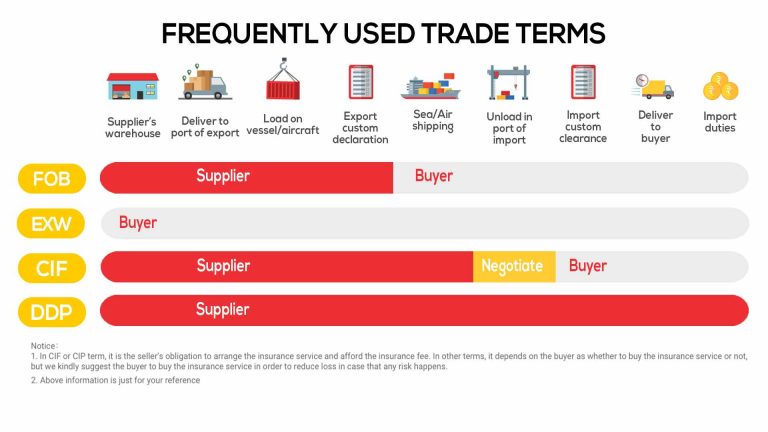CIF Incoterms is one of the most commonly used terms in international trade transport. Having a deep understanding of its meaning, usage scenarios, price calculations, and other aspects can be extremely helpful for practical trade. Below is a detailed introduction to CIF. We suggest you read it carefully.
What is CIF meaning in shipping?
CIF stands for Cost, Insurance, and Freight. It means the seller is responsible for transporting the goods from the seller’s warehouse to the destination port, and bears the costs, freight, and insurance fees during this process. However, the seller does not have to bear the risk of goods during sea transportation because the delivery is completed when the goods are loaded onto the ship at the port of shipment. After the goods arrive at the destination port, the buyer will handle customs clearance and transport them to the final destination.
The International Chamber of Commerce’s Incoterms 2010 saw significant changes compared to the 2000 version. One notable change was in the CIF (Cost, Insurance, and Freight) delivery terms. The concept of ‘ship’s rail’ was eliminated, and it was replaced with the idea of goods being loaded onto the ship. Additionally, responsibilities for transactions involving multiple buyers and sellers during transportation (known as chain transactions) were delineated. However, the CIF terms in 2020 have not changed much to the 2010 version, except that the optional insurance level has been increased to A.
When to use CIF?
- CIF is only used for maritime and inland waterway transportation. That’s why many bulk goods shipped by sea often use CIF. For smaller items, international express delivery is recommended.
- For buyers capable of completing import clearance and inland transportation, CIF is a good option.
- Sometimes, sellers may find it difficult to arrange for a freight forwarder to deliver goods directly to your warehouse and can only manage door-to-port transportation. In such cases, opting for CIF might be necessary. For instance, if you’re a buyer in Austria importing goods from China. Since Austria is a landlocked country without seaports and rarely imports directly from China, there’s a scarcity of freight forwarders specializing in door-to-door transportation from China to Austria. In such cases, sellers might only be able to deliver goods from China to major ports nearby Austria, like the Port of Rotterdam in the Netherlands, and then you would have to arrange for pickup from the port yourself. This type of door-to-port shipping most commonly uses CIF pricing.

When to transfer risk?
Before the goods are loaded onto the ship, if they get damaged or lost, it’s entirely the seller’s responsibility. However, once the goods are loaded onto the ship, the risk shifts from the seller to the buyer. In other words, from the start of sea transportation, it’s the buyer who bears the risk.
For example, if you and the seller agree on a delivery time, but the goods encounter a traffic accident on the way to the port of shipment, causing a delay in delivery, the additional costs such as late entry fees will be borne by the seller. Similarly, if the goods encounter rough seas during the voyage and half of them are lost, the insurance purchased beforehand can offset some of the losses, but the remaining losses are to be borne by the buyer alone. Throughout this process, the seller doesn’t bear any risk.

What are the responsibilities of buyers and sellers?
| Seller's Responsibilities | |
|---|---|
| Export Packaging | Delivery to Port of Shipment (including loading, inland transportation) |
| Export Customs Clearance | Port of Shipment Terminal Charges (including transportation, loading, and unloading at the terminal) |
| Ocean Freight | Insurance |
| Buyer's Responsibilities | |
|---|---|
| Port Charges at Destination | Unloading at Destination Port |
| Import Customs Clearance | Delivery to Final Destination |
Now let’s understand the responsibilities of the buyer and seller in a CIF transaction through an example. Suppose you purchase 40,000 pieces of clothing from Guangzhou, China. These clothes need to be shipped from Guangzhou Port in China to the Port of Los Angeles in the United States. Here’s what the seller and buyer need to do:

Seller's tasks:
1. The seller needs to start by packaging the products and arranging truck transportation and port booking in advance. After the goods are packed, they should be transported to Guangzhou Port. Another important thing to note is that in CIF transactions, it’s the seller’s responsibility to purchase insurance, preferably before the goods depart from the originating port. Therefore, insurance should be arranged after the products are packaged.
2. Next, the seller needs to arrange for loading and unloading of goods at Guangzhou Port and submit the relevant documents for export customs clearance. Any charges incurred during loading and unloading, documentation, or customs clearance are the responsibility of the seller.
3. Once these steps are completed, the seller can arrange for sea transportation. After the goods are loaded onto the ship, it means the goods are delivered to the buyer.
Buyer's tasks:
1. Since CIF requires the buyer to prepay the freight, you should pay the freight in advance based on the seller’s quotation before the seller ships the goods.
2. Once the goods are loaded onto the ship at Guangzhou Port, the risk transfers to the buyer. You need to bear the risk of damage or loss of goods during transit from Guangzhou Port to the final destination.
3. Upon arrival at the Port of Los Angeles, you need to obtain an import license, complete import customs clearance, and pay relevant taxes, fees, and port charges.
4. Finally, you need to arrange for the inland transportation of the goods and loading/unloading at the warehouse.

In a CIF transaction, there are quite a few tasks for the buyer to handle. Therefore, choosing an experienced and trustworthy freight forwarder can save you a lot of worries. It’s not easy to find a reliable freight forwarder among many forwarding companies, and it may require a lot of time and effort. If you don’t have your own freight forwarder, you can ask the seller for recommendations, as sellers usually have some cooperating freight forwarders.
What are the advantages and disadvantages of CIF?
Advantages
- CIF includes insurance fees, which can mitigate some risks associated with the goods. However, sellers typically purchase the minimum insurance coverage, so if buyers require higher compensation limits, it’s advisable to purchase additional insurance or negotiate with the seller to increase the coverage.
- Choosing CIF pricing, although involves certain risks for buyers, also allows for better control over the goods. After the goods arrive in your country, not only can you arrange for their handling to ensure they reach the destination safely, but you can also freely choose more favorable transportation methods.
Disadvantages
If the seller doesn’t handle transportation professionally, it could lead to many troubles.
- As the seller needs to manage export procedures and pay in advance, if the buyer doesn’t make specific requests, the seller might choose some very cheap shipping vessels, which could significantly prolong the transportation time.
- Additionally, because the seller is responsible for exports, they need to prepare certain documents for the buyer, such as importer security filing. If this is overlooked or not prepared in advance, it could result in hefty fines, ultimately borne by the buyer.
The buyer bears greater risks. Once the goods set sail from the exporting country, any damage or loss becomes the buyer’s responsibility. Furthermore, the buyer is responsible for import customs clearance, and if clearance encounters difficulties, the corresponding demurrage fees and other expenses are the buyer’s responsibility.
What is the CIF price?
The CIF price includes ocean freight, insurance, product cost, and other expenses. In other words, the CIF price equals the FOB price plus ocean freight and insurance.
For example, let’s say you’re a buyer from South Korea, and you’ve ordered 20,000 toys from Yiwu, China, and you want them shipped to Busan Port, South Korea. Goods from Yiwu usually get shipped out from the nearest Ningbo Port. So, the CIF price for this shipment equals the FOB price plus the ocean freight from Ningbo Port to Busan Port plus insurance. (Where the FOB price includes product cost, costs from the seller’s warehouse to Ningbo Port, export customs-related taxes, handling charges, document fees, etc.)
Ocean freight rates often fluctuate. Most countries and regions experience peak seasons from June to September, while other months are considered off-peak. During peak seasons, ocean freight rates may be slightly higher. Special events like the COVID-19 pandemic also have a significant impact on ocean freight. Before the pandemic, the cost of shipping a 40-foot container from Ningbo Port to Germany was around $3000, but during the pandemic, it could surge to $20,000.
When using CIF, you also need to choose between FCL and LCL. Generally, cargoes above 20 CBM (Cubic Meters) opt for FCL because FCL rates are lower, while the same CBM in LCL would cost much more. For cargoes between 15-20 CBM, you need to consult with the freight forwarder to determine which container loading method is more cost-effective.
When CIF is compared with other trade terms:
FOB stands for Free On Board, meaning the seller is responsible for loading the goods onto the buyer’s specified vessel at the port of shipment and notifying the buyer. Once the goods are loaded onto the ship, the risk shifts to the buyer. Both FOB and CIF involve delivery on board the ship, but under FOB, the seller isn’t responsible for arranging ocean freight and insurance.
CIF vs CIP
CIP stands for Carriage and Insurance Paid to (specified destination). Like CIF, the seller is responsible for insurance and freight costs, but the delivery point and transportation method differ between the two terms. CIP can be used for various modes of transportation such as air, land, and sea, and the delivery point isn’t limited to on board a ship but varies depending on the transportation method. CIP insurance doesn’t just cover marine insurance but also includes various other types of insurance.
CIF vs CFR
CFR stands for Cost and Freight, which means the seller covers the product cost and freight charges, and the delivery takes place on board the ship at the port of loading. The main difference between CFR and CIF is that under CFR, the seller doesn’t have to bear the insurance costs, and the buyer can decide whether to purchase insurance themselves.
CIF vs DDP
DDP provides door-to-door service, which is very suitable for novice buyers. The seller will transport the goods from the exporting country to the buyer’s warehouse in the importing country and bear all the expenses during the process, making it hassle-free for the buyer. The main difference between DDP and CIF is that under CIF, the seller doesn’t need to be responsible for import customs duties and inland transportation, while DDP requires the seller to bear these costs.
CIF vs EXW
EXW stands for Ex Works. It means the goods are delivered at the factory. The EXW price, also known as the factory price, typically includes only the cost of the product itself. The buyer bears all the risks throughout the entire transportation process. However, on the flip side, the buyer has more control over the goods. Compared to EXW, under CIF, the buyer has less responsibility and faces fewer risks. The CIF price includes the EXW price (product price) .
FAQ
How is CIF calculated?
CIF price = Product cost + Cost from warehouse to port of shipment + Export customs clearance fee + Ocean freight + Insurance fee = FOB price + Ocean freight + Insurance fee
Is CIF the same as DAP?
No, they are different. Under CIF, the seller only delivers the goods to the destination port, while DAP generally provides door-to-door service, where the seller transports the goods to the buyer’s specified location, such as a warehouse. However, neither requires the seller to be responsible for import customs clearance or pay taxes.
What is CIF incoterms 2020?
- The Incoterms are typically updated every ten years, and the CIF term has hardly changed from the 2010 version to 2020 except for the insurance level being raised from C to A.
- CIF is one of the 11 Incoterms rules set by the International Chamber of Commerce, which stands for Cost, Insurance, and Freight. It means the seller is responsible for transporting the goods from their warehouse to the destination port and covering the costs of the product, freight, and insurance during this process. After the goods arrive at the destination port, the buyer completes customs clearance and transports them to the final destination.
As Incoterms 2020 says, the insurance to be provided under CIF has changed, increasing from Institute Cargo Clauses(C) to Institute Cargo Clauses(A). Now the Institute Cargo Clauses (C) remains the default level of coverage, but we have the option of a higher level of insurance.
Does the CIF term require the seller to be responsible for customs clearance?
No, generally this is the buyer’s responsibility.
I have a shipment that needs to be shipped by air. Can I use a CIF contract?
No, the CIF term is not applicable for air freight. If you want to ship by air, it is recommended to choose CIP which also comes with insurance.
Is the 2000 version of CIF still available?
Yes, it’s available. The International Chamber of Commerce’s Incoterms themselves aren’t mandatory, so the emergence of a new version doesn’t mean the previous one can’t be used anymore. Now, if you want to use the 2000 version of CIF in a formal contract, you need to specify ‘as per Inco terms 2000’.
The End
Hope you have a clear understanding of CIF shipping terms after reading this article. If you have any questions, you can leave a comment below.
We are JingSourcing, a leading sourcing company in China. We have served 4000+ clients buying or customizing products from China.We can help you follow up the whole importing process, do product inspection and arrange shipment. Our one-to-one sourcing agent and experienced team will help you solve any problems when importing from China. Feel free to CONTACT US if you need.
